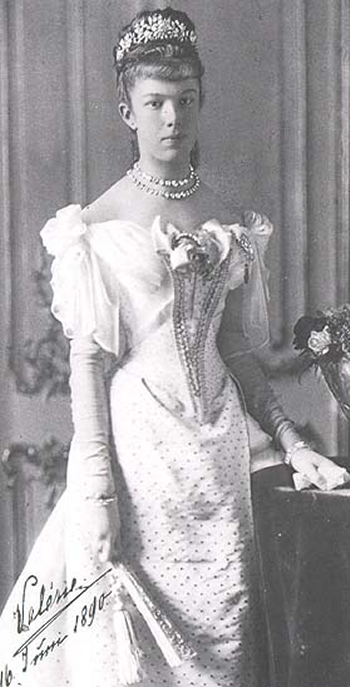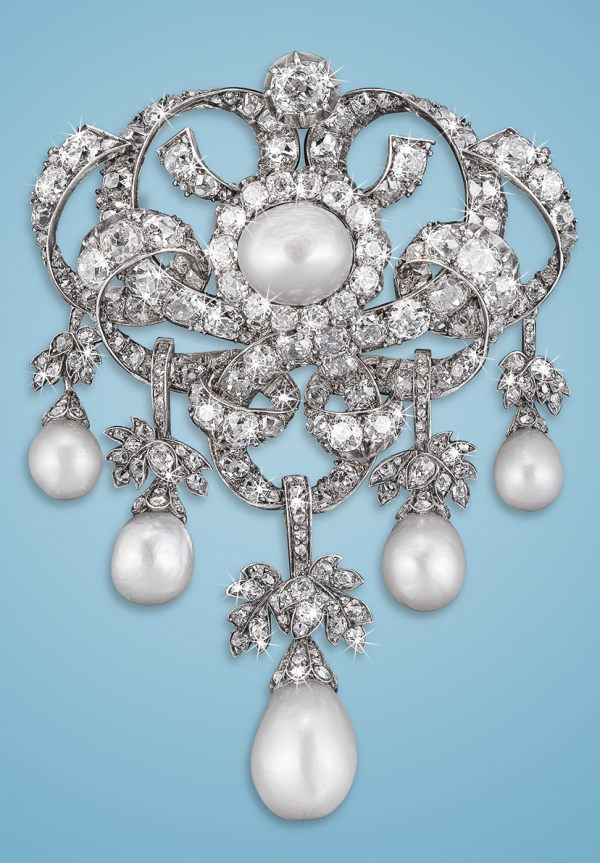 |
| Christie’s |
Last week, we talked about the jewels once owned by the late Lady Granard, several of which were up for sale at Christie’s. That same sale also included numerous other intriguing pieces of jewelry, including this diamond and ruby necklace — which may particularly fascinating royal legacy.
 |
| Christie’s |
The necklace is described in the lot notes from Christie’s as a “mid-19th century ruby and diamond necklace,” made of “oval-shaped rubies, old-cut diamonds, silver and gold.” They date the necklace to the 1850s, and they note that it was offered for sale in the November 12 auction by “a European family.”
 |
| Cornelia, Countess of Craven, ca. 1914 (Grand Ladies Site) |
The necklace has had at least one illustrious former owner. Cornelia, Countess of Craven, received the necklace from her parents. Like Beatrice Granard, Cornelia was one of the buccaneers, a group of wealthy American heiresses who married into the British aristocracy at the turn of the twentieth-century. Cornelia’s parents were Mr. and Mrs. Bradley Martin of New York, who were famous for throwing the lavish Bradley-Martin Ball at the Waldorf in 1898. Five years earlier, in 1893, sixteen-year-old Cornelia had married the 4th Earl of Craven and become Countess of Craven.
 |
| Christie’s |
The lot notes also include a nugget of interesting information. In describing the attire worn by Cornelia’s mother, Mrs. Bradley Martin, to the famous 1898 ball, Christie’s notes that she wore “a fabulous ruby and diamond necklace, rumoured to have been the one that previously belonged to Madame Royale, Duchess of Angoulême.”
 |
| Replicas of the original Nitot ruby jewels made for Empress Marie Louise, recently displayed in Monaco (and shared with us by Royal Warren(t), who owns the copyright to this image!) |
The Duchess of Angoulême’s parure of ruby jewels dated to 1816, but the rubies themselves had previously been set in a suite of jewels that belonged to another French royal woman: Empress Marie Louise, the second wife of Napoleon Bonaparte. Her ruby parure was made for her by Nitot, and the stones were later reused by Bapst to create a parure for the Duchess of Angoulême (who was the only surviving child of Louis XVI and Marie Antoinette). We recently discussed the Nitot parure here on the site — the photograph above showcases garnet-set replicas of the original jewels.
 |
| Madame Royale: Princess Marie Therese of France, Duchess of Angouleme by Caminade, 1827 (Wikimedia Commons) |
The Angoulême rubies stayed in France even after the Duchess went into exile, and they were later worn by Empress Eugenie. Along with the rest of the crown jewels, the rubies were sold at auction in 1887. There’s no clear record of where they ended up, but we know that part of the set — the ruby tiara — was later owned by none other than Cornelia, Countess of Craven. Did the necklace end up with her, too? We don’t know whether the Angoulême necklace and the Bradley-Martin Ball necklace and Cornelia Craven’s necklace were all versions of the same piece of jewelry — or at least set with the same gemstones — but the lot notes certainly seem to want us to entertain the possibility.
The Angoulême ruby tiara was famously auctioned at Sotheby’s in 1961 with the rest of Cornelia Craven’s jewelry, following her death earlier that year. (The sale was an enormous one — one paper described it as “one of the biggest jewel sales ever held in Britain.”) The tiara was described as having belonged to the Empress Eugenie, and it sold for $92,000. The ruby and diamond bracelets from the Angoulême parure (also owned by Cornelia) were auctioned in the same sale as well; today, they’re in the Louvre. But the necklace, which we know was also sold in that same auction, was not described as coming from Empress Eugenie’s collection, which makes me think it was more likely a separate piece, not originally associated with the Angoulême rubies at all.
 |
| Christie’s |
Anyway, here’s what we know for sure: this ruby necklace was sold at Sotheby’s in 1961, following Cornelia Craven’s death — and it was sold again last week, on November 12 at Christie’s in Geneva. Auction estimates for the piece this time around were set at 350,000-550,000 Swiss francs (which are currently roughly equivalent to US dollars). When the hammer fell, the necklace brought home even more money than anticipated, selling for 615,000 Swiss francs (including the buyer’s premium).



















